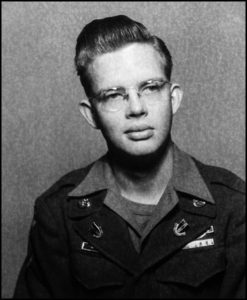
Vernon Wold
Guarded German
prisoners at Dachau
Vernon Wold
Colonel, U.S. Army, Ret.
1943–1946 & 1951–1975

PFC Vernon Wold
Germany, 1945
Then I was at Dachau as a guard supervising a Polish battalion.
I grew up in Fergus Falls, Minnesota, and graduated high school in 1943 at age 17. The Army had a specialized training program for college. I took the examination and went to the University of Kansas. Then the Army canceled the program and sent us to Camp Roberts’ infantry replacement center. After 17 weeks we’d go as infantry replacements to a unit. Since some of us wouldn’t be 18 in 6 months we went to Camp Shelby, Mississippi to the 65th Infantry Division.
We got to Europe the end of January, 1945, right after the Bulge. We were in Patton’s Third Army. Patton was well known, well liked, and he did a job that had to be done. It was the best fighting army of the Army. In 60 calendar days we had 55 days of combat.
Each infantry battalion had a platoon of 57mm anti-tank guns. I was a gunner. We were in the Battle of Struth on April 7, 1945. We were with an armored division and our mission was to head north as far as you can, as fast as you can. We went for nine days and then we were halted. We were sitting there at Struth and the Germans made a counterattack. They were trying to recover 2-3 billion in Reichsmarks and a gold reserve in a potash mine at Merkers. They didn’t get it.
After the war, the rotation back to the States was based on points. If you were an 18-year-old kid, you were at the end. I got back in May,1946. During that year I went to school. Then I was at Dachau as a guard supervising a Polish battalion. The lesser-degree war crimes trials were at Dachau and we had probably 55,000 German prisoners.
We knew pretty well what happened there. When Dachau was taken, they did nothing with the crematory and we had to clean up. It wasn’t easy duty, but you were told what to do and did it. We got it into shape so it could be kept on as a memorial.
After I got home I went to college at the University of Minnesota. I took pharmacy and graduated in May, 1950. Through ROTC I became a Distinguished Military Graduate and got a commission. I turned it down and went to work as a pharmacist. I was a lieutenant in the reserves. After being a pharmacist for about a year, I volunteered and got my regular Army commission. The Korean War had started and I decided that I wasn’t going to be a pharmacist.
In Korea I had an aid station. We took care of the casualties of the First Battalion. I was there twelve months. When I got back I went to the medical depot in St. Louis. We provided medical supplies to the Army. In the late 1950’s I went to France to the Army medical depot for three years. Afterward at Fort Sam Houston, I was an instructor in medical logistics. I got a master’s degree in computer science and management information systems and was in the Surgeon General’s office for six years in Washington. I then headed up medical matériel activity as director.
My best day in WWII was also my worst day—the Battle of Struth. It was the best day because we knocked out two German tanks. It was our worst day because we lost half the squad. We were attacked by a much superior force. The Germans hit us with about 50 tanks, and 3,000 personnel. We were able to hold our own until reinforcements came in. We won the battle. {07-06-2017 • San Antonio, TX)